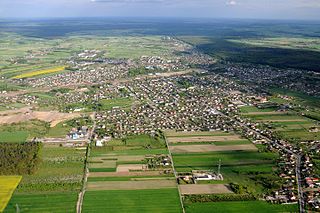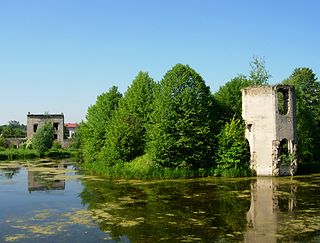
Łask is a town in central Poland with 16,925 inhabitants (2020). It is the capital of Łask County, and is situated in Łódź Voivodeship. The Polish Air Force's 32nd Air Base is located nearby. It is located in the Sieradz Land.

Pionki is a town in Radom County, Masovian Voivodeship, central Poland with 18,846 inhabitants (2016). Surrounded by the Kozienice Wilderness, Pionki is located in northern part of historic province of Lesser Poland, 20 kilometres from Radom, and 105 kilometres from Warsaw.

Kurów ( ) is a village in south-eastern Poland, located in the historic province of Lesser Poland, between Puławy and Lublin, on the Kurówka River. It is capital of a separate gmina (municipality) called Gmina Kurów, within Lublin Voivodeship. The village has 2,725 inhabitants.

Dębno is a town in Myślibórz County, West Pomeranian Voivodeship in western Poland. As of December 2021, the town has a population of 13,443.

Żarki is a town in Myszków County, Silesian Voivodeship, Poland, with 4,556 inhabitants (2019). The history of Żarki dates back to the early 14th century, as the village was first mentioned in documents from the 1320s. For centuries, Żarki belonged to Lelow County, Kraków Voivodeship, historic province of Lesser Poland.

Kock is a town in eastern Poland, about 45 kilometres north of Lublin and 120 kilometres south-east of Warsaw. It lies in Lublin Voivodeship, in Lubartów County. It is the capital of the administrative district Gmina Kock. Historically Kock belongs to the Polish province of Lesser Poland and is located in its northeastern corner. As of 2004, its population numbered 3,509.

Opatów is a town in southeastern Poland, within Opatów County in the Świętokrzyskie Voivodeship. Historically, it was part of a greater region called Lesser Poland. In 2012 the population was 6,658. Opatów is located among the hills of Lesser Polish Upland, with the Opatówka river dividing the town into two parts. Tourist attractions include a 12th-century Collegiate Church of St. Martin, 15th-century baroque Bernardine monastery, 16th-century city gate and town hall as well as several other notable buildings.

Zwoleń is a town in eastern Poland, in Masovian Voivodeship, about 30 kilometres east of Radom. It is the capital of Zwoleń County. Population is 8,048 (2009). Zwoleń belongs to Sandomierz Land of the historic province of Lesser Poland, and is located on the Zwoleńka river.

Szydłowiec is a town in Szydłowiec County, Mazovian Voivodeship, south-central Poland, with 5,243 inhabitants. It is the seat of Gmina Szydłowiec (commune). Szydłowiec is part of the historic region of Lesser Poland.

Staszów is a town in southeastern Poland, in Świętokrzyskie Voivodeship, about 54 kilometres southeast of Kielce, and 120 km (75 mi) northeast of Kraków. It is the capital of Staszów County. The population is 15,108 (2010), which makes it the 8th largest urban center of the province. The area of the town is 26,88 km2, and its two rivers are the Desta and the Czarna Staszowska.

Kałuszyn is a town in Poland, seat of the Gmina Kałuszyn (commune) in Mińsk County in Masovian Voivodeship.

Iłża is a small town in Masovian Voivodeship, Poland. In 2006 Iłża had approximately 5,165 inhabitants. The town belongs to the historical region of Lesser Poland, and from its foundation until 1795, it was part of Lesser Poland’s Sandomierz Voivodeship. Iłża lies in Małopolska Upland, on the Iłżanka river, 30 kilometers south of Radom.

Koluszki is a town, and a major railway junction, in central Poland, in Łódź Voivodeship, about 20 km east of Łódź with a population of 12,776 (2020). The junction in Koluszki serves trains that go from Warsaw to Łódź, Wrocław, Częstochowa and Katowice. It is also connected to Radom and Lublin by an eastbound line.

Żychlin is a town in Kutno County, Łódź Voivodeship, Poland, about 50 north of Łódź and 90 kilometres west of Warsaw. It has 7,964 inhabitants (2020).

Jedlińsk is a village in Radom County, Masovian Voivodeship, in east-central Poland. It is the seat of the gmina called Gmina Jedlińsk. It lies in historic Lesser Poland, approximately 14 kilometres (9 mi) north of Radom and 79 km (49 mi) south of Warsaw along the E77 Highway.

Ćmielów is a town in Ostrowiec County, Świętokrzyskie Voivodeship, Poland, seat of Gmina Ćmielów. As of December 2021, it has 2,954 inhabitants. It is known for one of Poland's oldest porcelain factories dating back to 1790. The town history dates back to 14th century. It has several tourist attractions, in addition to its old porcelain factory, including ruins of a 16th-century castle and a church from the same period. Ćmielów belongs to Lesser Poland, and lies on the Kamienna river in the Sandomierz Upland, 10 kilometers east of Ostrowiec Świętokrzyski, along local road nr. 755.

Tuliszkówpronounced[tuˈliʂkuf] is a town in Turek County, Greater Poland Voivodeship, in central Poland, with 3,373 inhabitants (2010).

Drzewica is a town in Opoczno County, Łódź Voivodeship, Poland, with 3,778 inhabitants as of December 2021. From 1975 to 1998 the town was a part of Radom Voivodeship. Located on the Drzewiczka river, in the northwestern corner of the historic province of Lesser Poland, Drzewica is home to Gerlach, a renowned cutlery manufacturer, founded in 1760 in Warsaw. In the first half of the 16th century, the Archbishop of Gniezno and Primate of Poland Maciej Drzewicki built here a rectangular-shaped castle, surrounded by a moat. The castle burned in 1814 and now is a well-preserved ruin.

Sienno is a city in Lipsko County, Masovian Voivodeship, in east-central Poland. It is the seat of the gmina called Miasto i Gmina Sienno. It lies some 15 kilometres (9 mi) south-west of Lipsko and 130 km (81 mi) south of Warsaw.

Jastrząb is a town in Szydłowiec County, Masovian Voivodeship, in east-central Poland. It is the seat of the gmina called Gmina Jastrząb. It lies approximately 8 kilometres (5 mi) east of Szydłowiec and 108 km (67 mi) south of Warsaw. Jastrzab belongs to Lesser Poland, and used to be a town from 1427 to 1869.
























